Chapter 1.
DATING THE NATIVITY OF CHRIST AS THE MIDDLE OF THE XII CENTURY.
DATING THE NATIVITY OF CHRIST AS THE MIDDLE OF THE XII CENTURY.
1. WHY IS IT NECESSARY TO GO BACK TO THE DATE OF JESUS CHRIST ONCE AGAIN?
In our previous works we gave a lot of consideration to the date of the Nativity of Christ as one of the major milestones of the chronology. A number of bright reflections-duplicates of the Gospel events appeared in ‘Scaliger’s textbook’ in the XI century. In particular the ‘biography’ of Gregory (VII) Hildebrand, see [MET1] and CHRON1, CHRON2, ch.2:1. Then the description of the star of Bethlehem – the flare of allegedly 1054, also fell into the same XI century. Fig.1.1
 and fig.1.2
and fig.1.2 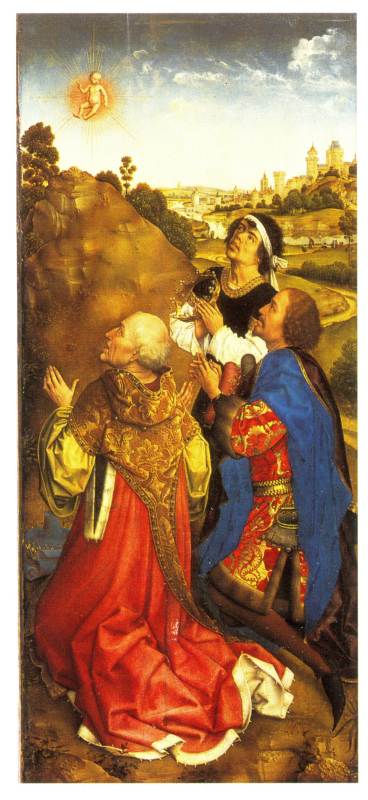 show two of many old depictions of the star of Bethlehem heralding the birth of Christ.
show two of many old depictions of the star of Bethlehem heralding the birth of Christ.
As we showed in ‘Bibleiskaya Rus’ (‘Biblical Russia’ – Tr.) and CHRON6, ch.19, the Mediaeval calculations of the dating of the Nativity of Christ resulted in the following: 1068 (for Nativity) and 1095 (for Crucifixion), i.e. the end of the XI century, see [��] and CHRON6, ch.19. These exact dates survived in the church tradition of the XIV-XV cc.
However, strictly speaking, the question of the dating of Christ’s life remained unclear as all the presented dating was not absolute. For instance, the star of Bethlehem of 1054 was taken from the chronicles. The mediaeval dating of the Crucifixion reflected essentially only the opinion of the XIV-XV cc. chronologists. It is possible that they were mistaken. That is why we shall return to this important question one more time. The answer we arrived at – the middle of the XII century – which we will describe in detail later, differs by approximately a hundred years from the listed dates and is most likely final. The fact is that NOW IT IS SUPPORTED BY SEVERAL DATING RESULTS WHICH ARE ENTIRELY INDEPENDENT FROM EACH OTHER, INCLUDING THE ABSOLUTE ONES.
2. THE STAR OF BETHLEHEM FLARED UP IN THE MIDDLE OF THE XII CENTURY (THE ABSOLUTE DATING OF CHRIST’S LIFE).
We will use the fundamental work by I.S.Shklovsky ‘Supernovae and some related problems’ [149]. Its third chapter is almost entirely devoted to the ‘star of 1054’. The remnants of this flare is the modern Crab Nebula in Taurus [149], p.63-67.
We will say straight away, that the date of ‘1054’ was taken from the old chronicles, in particular the Chinese and the Japanese ones, which I.S.Shklovsky fully trusts. But we do not have any reasons to do so. Moreover, it is completely unnecessary to draw on such questionable data. Apparently you can determine a date for this particular supernova flare PURELY ASTRONOMICALLY and to a high precision. This was done by the American astronomers in the XX century. That is what we will talk about now.
We shall clarify what we are going to talk about. The supernova outburst is an explosion in the universe. After the explosion the fragments of the star disperse from the place of the catastrophe. We can take it that during the first several thousand years the velocity of the supernova remnants is steady, as outer space offers almost no resistance. The collisions with extra-terrestrial objects and ‘cosmic dust’ manifests itself over vast time intervals. Where it could only concern the gradual breakdown of the flying ‘fragments’. And not their accelerated velocity. Hence a simple and reliable method of the ‘ABSOLUTE DATING of the explosion, a supernova outburst. We need to measure the expansion velocity of the ‘remnants’ and the distance they could fly away at. Having then divided the distance by the speed we’ll get the time period of the expansion. Counting back the time we arrive at the date of the explosion. And notably modern technology allows us to accomplish this with a high degree of accuracy.
K.Lundmark appears to be the first to point out in 1921 in his notes to his famous catalogue of the historical novae, that in place of a ‘guest-star’ of allegedly 1054 known via the old chronicles, there is the Crab Nebula there today (K.Lundmark, see: Festkrift Tilla"gnat O".Bergstrand, Uppsala).
Independent from this work ‘in the very same 1921 … there appeared two very important studies of the Crab Nebula. Lampland discovered the variability of this nebula (C.O.Lampland. Publ. Astron. Soc. Pacific 13, 79, 1921), and Dunkan found that its separate parts scatter in a radial axis. (J.C.Dunkan. Proc. Nat. Acad. Sci. USA 7, 170, 1921)" [149], p.63-67. Dunkan estimated that the moment at the beginning of the dispersion was approximately 900 years away from his time, i.e. from 1920. This gave the scientists even more reasons to identify the Crab Nebula as the remnants of the star which flared up allegedly in 1054. We shall repeat that the ‘historical dating’ of the explosion as 1054 was taken from the chronicles. However the researches that followed showed that the time period was not estimated by Dunkan accurately enough.
In 1942 astronomer ‘Baade selected those results of Dunkan which concerned the concentrations situated close to endpoints of the major axis of the Crab Nebular (W.Baade. 1942, Astrophys.J. 96, 109). Evidently this data is of main interest. After entering the required reductions he obtained magnitude of the proper motion for these concentrations in the direction of the major axis equal 0",235 plus-minus 0",008 per year. As the major axis value contemporary to Baade’s work was a=178" plus-minus 5", then from the obtained proper motion in the direction of the major axis the nebula age can be obtained (on the hypothesis that the expansion occurs with constant velocity). This age appears to be 758 years” [149], p.223-225.
Let us subtract a quantity of 758 years from year 1942. We’ll obtain year 1184 as an approximate date of the star explosion.
Soon this estimated date was defined more accurately by the American astronomer V.Trimbl [182]. ”In 1968 Trimbl carried out an important measurement of the proper motions of the 132 filaments of the Crab Nebula using the photographs obtained by the 100 and 200-inch telescopes in the Mount Palomar observatory (V.Trimbl. AJ 73, 535, 1968). The photographs were obtained through a filter … which provides the excellent clear image of the filaments system… The photographs used by Dunkan were made without a filter and on a smaller scale. While processing these photographs Trimble used the radial velocity of 127 filaments obtained by different authors. In fig.1.3 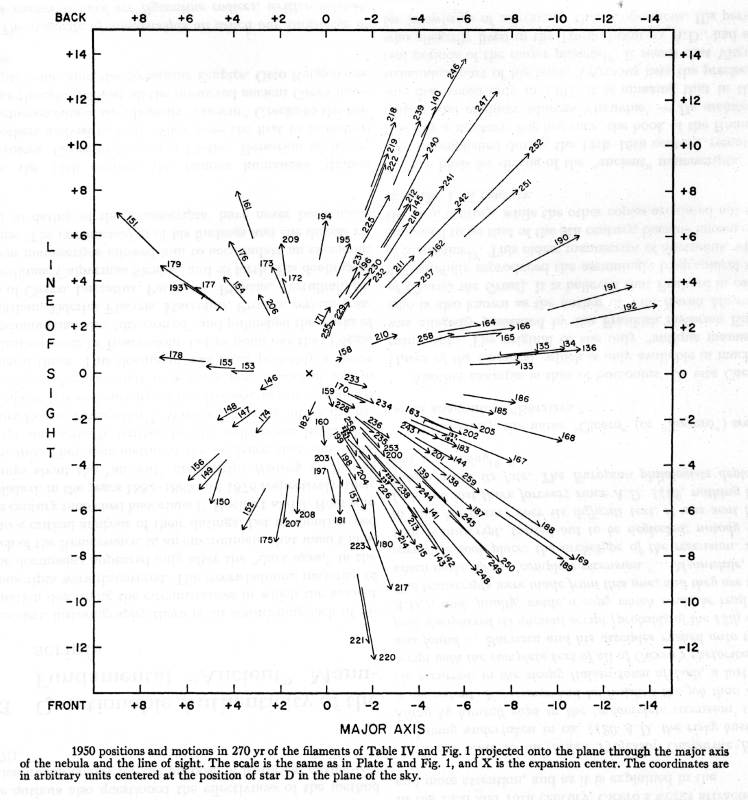 are given the vector distance projections of the filaments over the period of 270 years" [149], �.223-225. In fig.1.3
are given the vector distance projections of the filaments over the period of 270 years" [149], �.223-225. In fig.1.3  and fig.1.4
and fig.1.4  , which we borrowed from the original article by V.Trimble [182], we can see the projections of vector distance (in relation to the observation point from the Earth) onto two plains passing through the line of sight and the major and the minor axis of the Crab nebula respectfully. The given 270 years set here the conditional time interval for which the shifting of the star’s ‘splinters’ was calculated and shown DIAGRAMMATICALLY) [182].
, which we borrowed from the original article by V.Trimble [182], we can see the projections of vector distance (in relation to the observation point from the Earth) onto two plains passing through the line of sight and the major and the minor axis of the Crab nebula respectfully. The given 270 years set here the conditional time interval for which the shifting of the star’s ‘splinters’ was calculated and shown DIAGRAMMATICALLY) [182].
V.Trimble discovered that ‘these vectors converge to a small area – the centre of the explosion – offset by 12" towards South-East from the south star in the central part of the nebula, which, as it is proved now, is the stellar debris of the supernova in 1054. The determination accuracy of the point of convergence of velocity vectors of filaments is equal to 3". At the constant travel speed of filaments they should have all situated in the minor volume circa 1149 plus-minus 10 years’ [149], p.223-225.
To note, I.S.Shklovsky makes an error when citing V.Trimble’s results. The original article by V.Trimble doesn’t contain any estimated accuracy of ‘plus-minus 10 years’ which I.S.Shklovsky is talking about. V.Trimble doesn’t introduce any assessments of accuracy, though takes notice of the fact that the scattering of the dates of the explosion received according to various observation groups, amounts to 16 years [182], p.540. This gives the estimated accuracy of the dating of around 20-30 years. For instance, in the article by Richard Nuvert, V.Trimble’s is quoted with the estimated accuracy of 15 years [175]. There are notable words by V.Trimble that the observed proper motions of the star’s ‘splinters’ DO NOT BRING US TO THE ‘HISTORICAL’ DATE OF YEAR 1054.
TO CONCLUDE. THE SUPERNOVA IN TAURUS CONSTELLATION FLARED UP BETWEEN 1110 AND 1170 A.D., AND BY NO MEANS IN 1054 A.D., as the scientists thought according to the questionable interpretation of the old historical texts.
It changes the dating of the Star of Bethlehem which we used before and moves it from the XI into the XII cc. a hundred years closer to us. We would like to highlight, that the dating of the XII century is absolute, entirely independent from the Scaligerian chronology. Nothing ‘extraneous’ was used in it, apart from the precise modern astronomical observations and calculations.
The article by V.Trimble contains an interesting and fairly accurate conclusion: the movement of the Crab Nebula elements in space could have been exceptionally unusual providing that the nebula is the remnant of specifically the 1054 explosion. To clarify, V.Trimble calculated the place in the outer space where the explosion occurred. But it turned out that the central star of the nebula, which is the stellar remnant of the explosion, according to its own movement, would have occupied a DIFFERENT POSITION in 1054, variant from the one calculated by V.Trimble. This contradicts the hypothesis that the explosion occurred in 1054. If the star flared up in the middle of the XII century, circa 1140, plus-minus 20-30 years, then no contradictions occur.
The dating of the explosion achieved by V.Trimble in 1968 was later attempted to be made more precise by Wyckoff and Murray in 1977 [185]. For that they used both old observations of the Crab Nebula (the first photo of which was made in 1899 [185], p.719), - including the observations by V.Trimble, - and the new ones, up until the observations in 1976 – the most recent in their time [185], p.718. Besides they moved to the inertial reference system unrelated to the Earth. Their conclusion was that the explosion took place in 1120 plus-minus 7 years. Here we rounded off the value given by them: 1119,8 plus-minus 6,6 [185], p.724.
The analysis of their article shows, that the estimated accuracy suggested by Wyckoff and Murray amounts to a 50% confidence interval [185], p.719-720. I.e. meaning that the probability of the actual moment of the outburst being situated in the suggested interval is not so great. From the table presented by them on p.720 it follows that the confidence interval with a sufficiently high confidence level (‘three sigma’) has a value four times greater – i.e. around 20-30 years. Therefore, strictly speaking, the result achieved by them means, that the explosion took place in the interval between 1090 and 1150.
We will also note the article by R.Nugent which appeared in 1998 and dealt with the same problem [175]. The result Nugent arrived at was as follows: the explosion occurred in 1130 plus-minus 16 years. However the estimated accuracy is again overstated. He used the observations up to 1992 taken from the scientific literature and analysed them on the computer. The span of his ratings spread over the various groups of observations amounts to 68 years, and therefore the true accuracy is in the region of 30-35 years (a half of the estimated value). That is why the results by Nugent strictly speaking mean that the star flared up approximately in the interval between 1110 and 1160.
We could have finished this chapter here. However we cannot pass by such an incredible fact of how much ‘pressure’ the Scaligerian chronology puts on the modern astronomers. Here what it’s all about. Even after the presented above accurate astronomical results achieved by V.Trimble, the astronomer I.S.Shklovsky manages to draw a conclusion that the guest star still flared up in 1054, ‘in accurate accordance with Chinese chronicles’. However to achieve the ’accurate accordance with history’ he had to speculate that the ‘remnants’ scatter from the centre of the explosion with ACCELERATED speed [149], p.225. I.S.Shklovsky doesn’t offer any explanations of what mysterious forces determine the allegedly ‘secular acceleration’ of the filaments. As in order for the remnants to move with the ACCELERATED speed there should be some force affecting them. And what’s important – ALREADY AFTER the explosion occurs. We would like to stress that such speculation is completely unsubstantiated and is purely an attempt to force the data to fit the predetermined ‘historically correct answer’.
Moreover the research by Wyckoff and Murray showed that at the present time the accelerated velocity of the star’s ‘fragments’ is virtually ABSENT. Naturally such conclusion is made within the accuracy of the modern measurements sufficient for our purposes [185], p.727. Wyckoff and Murray compared the ‘fragments’ velocity values before 1970 and after 1970. The velocity information turned out to be matching. Their conclusion is: ‘If the pulsar has ever had any acceleration following the explosion, this acceleration was there only at first after its occurrence’ [185], p.727. But then a fair question arises: what mysterious forces caused such acceleration and why did they disappear later? We shall repeat that with the aid of ‘unexplored forces unknown to anyone’ it is possible in principle to prove absolutely anything.
Incidentally when they talk about the explosions not mentioned in the ‘super reliable Chinese chronicles’ the astronomers having been liberated from the oppression of the Scaligerian chronology, date such explosions on the assumption of the PROPORTIONAL expansion of the star’s remnants. Where a correction of the date might be necessary towards making it younger. The matter is that outer space which is filled with gas, dust, etc. offers some resist however insignificant. As the result the ‘fragments’ might slightly break, i.e. move with deceleration. But certainly not accelerating! See, for example, a popular discussion of this matter on the NASA (web) site: imagine.gsfc.nasa.gov/docs/science/know_12/supernova_remnants.html.
In fig.1.5 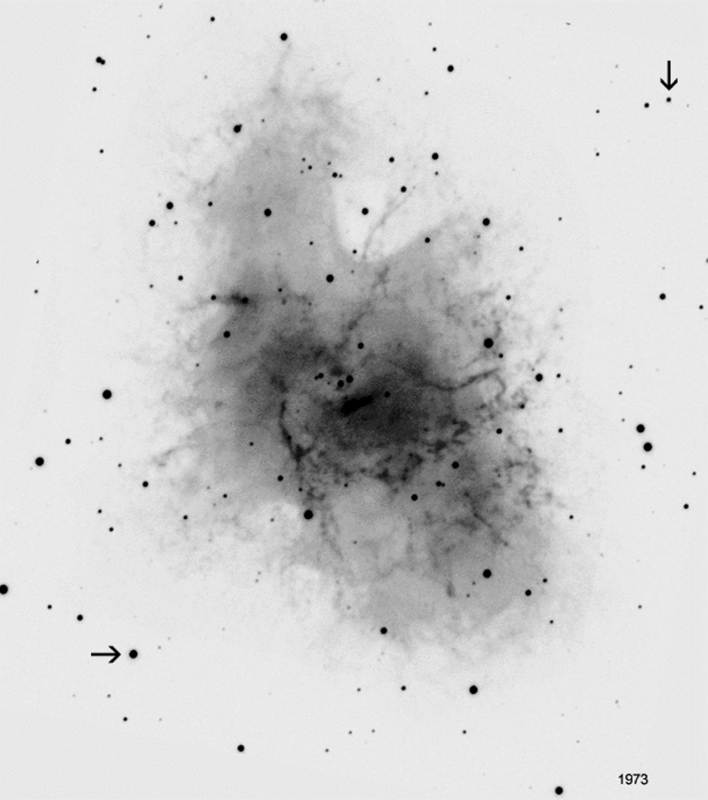 and fig.1.6
and fig.1.6 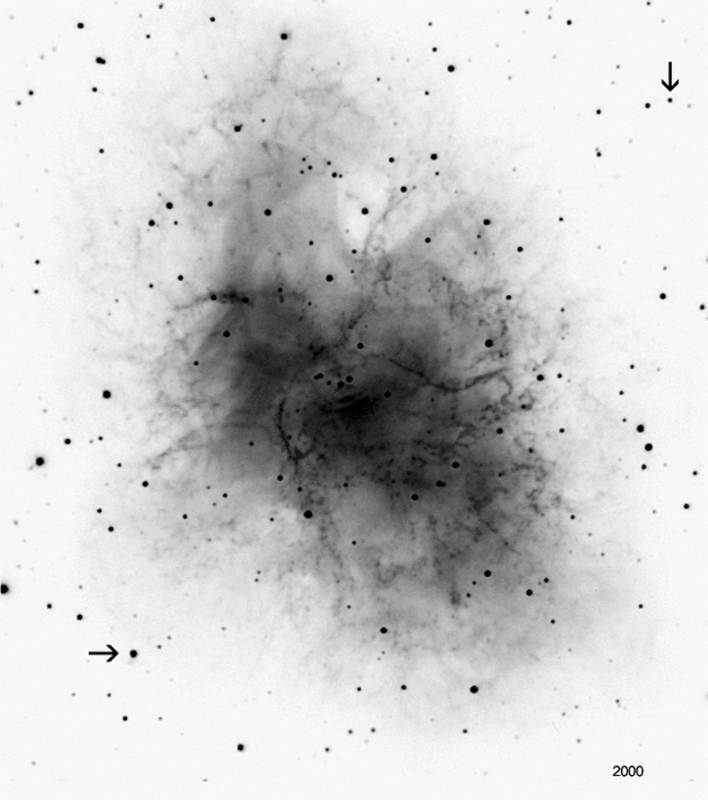 there are shown two photographs of the Crab Nebula in 1973 and 2000.
there are shown two photographs of the Crab Nebula in 1973 and 2000.
Thus, let us conclude. A reliable astronomical dating of the Star of Bethlehem is as follows: 1140 plus-minus 20-30 years. I.e. the MIDDLE OF THE TWELFTH CENTURY.
IN ADDITION ABOUT HALLEY’S COMET. Today we know that the return period of Halley’s comet amounts to approximately 76 years. See, for example, the discussion of this matter in CHRON5 and our book ‘Imperia’(‘The Empire’- Tr.). Considering that the second to last time Halley’s comet appeared in 1910, it is easy to calculate that around 1910 – 760 = 1150 Halley’s comet should have also appeared. We do not know whether it was well or badly visible that year. But if it really did appear in the sky in the same spectacular manner as it had done in the XVII-XX cc. (as in 1910 for instance), then over the next several years there could have been observed in the sky the two bright phenomena – the flare up of a star circa 1150 and Halley’s comet circa 1150. Naturally this would have made an even stronger impression on the people. Later the two phenomena could have been mixed up and combined. It is said in the Gospels, that the Star of Bethlehem was MOVING and leading the Magi. This reminds us of the behaviour of a comet: ‘lo, the star which they saw in the East WENT BEFORE THEM, TILL IT CAME AND STOOD over where the young child was’ (Matthew 2:9). Fig.1.7 shows one of the old depictions of the Gospel Star of Bethlehem in the form of a ‘star with a tail’. Thus they depicted the comets in the old days. An even more straightforward depiction of the Star of Bethlehem in the form of a comet we can see in Giotto’s ‘The Adoration of the Magi’, see fig.1.8  . The comet’s tail stretches upwards to the left, which means, that the artist, most likely, painted this exact comet, and not, let’s say, a star with its beam pointing at the infant Christ, see. fig.1.9
. The comet’s tail stretches upwards to the left, which means, that the artist, most likely, painted this exact comet, and not, let’s say, a star with its beam pointing at the infant Christ, see. fig.1.9  .
.
It is curious that in the Mediaeval painting by Albrecht Altdorfer ‘Holy night’ above on the left there are depicted TWO CELESTIAL BODIES marking the Nativity, see fig.1.10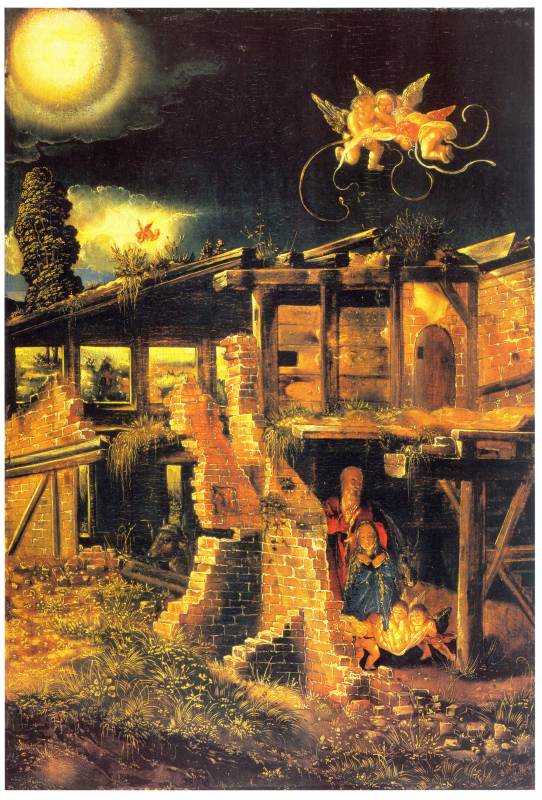 . One of them is a huge Star of Bethlehem in a form of the spherical flare. A little bit below there is a more outstretched wreathing luminary, inside of which a little angel is depicted.
. One of them is a huge Star of Bethlehem in a form of the spherical flare. A little bit below there is a more outstretched wreathing luminary, inside of which a little angel is depicted.
An analogous image of specifically two celestial ‘flashes’ announcing the birth of Christ we can see on the well-known Mediaeval Paumgartner-Altar created by Albrecht Durer allegedly in the XVI century. Its central composition ‘The Nativity’ is shown in fig.1.11  . We can see the orbicular flash of the Star of Bethlehem, and a little below (as incidentally in the painting by Altdorfer) – the outstretched wreathing luminary with an angel inside, see fig.1.12
. We can see the orbicular flash of the Star of Bethlehem, and a little below (as incidentally in the painting by Altdorfer) – the outstretched wreathing luminary with an angel inside, see fig.1.12 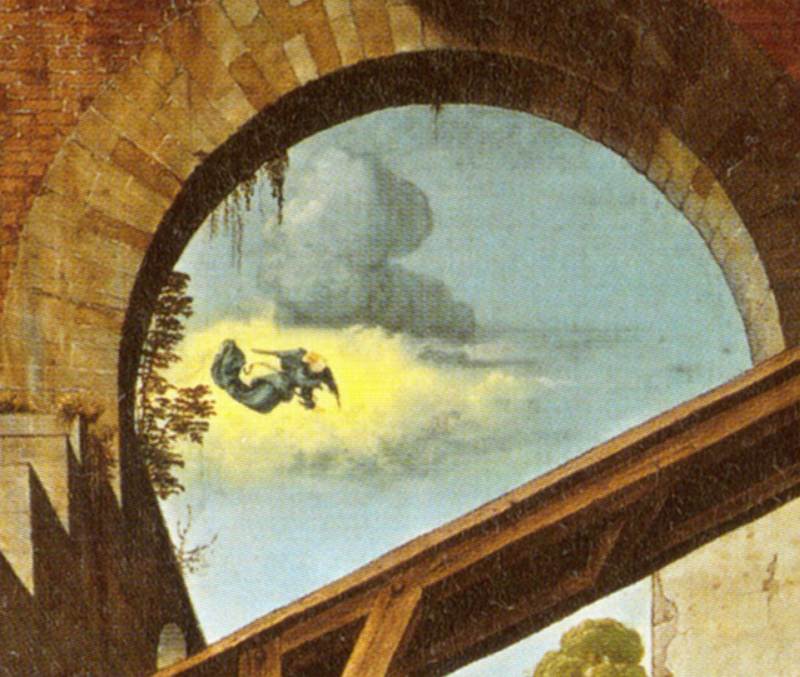 . On both of these paintings a pair of celestial luminaries is depicted with the bright yellow golden colour, striking one’s eye against the darker background of the rest of the scenery.
. On both of these paintings a pair of celestial luminaries is depicted with the bright yellow golden colour, striking one’s eye against the darker background of the rest of the scenery.
Thus, such mediaeval images convey, it appears, the old tradition to connect both the flare up of a star and a comet, which appeared at the same time as the Nativity.